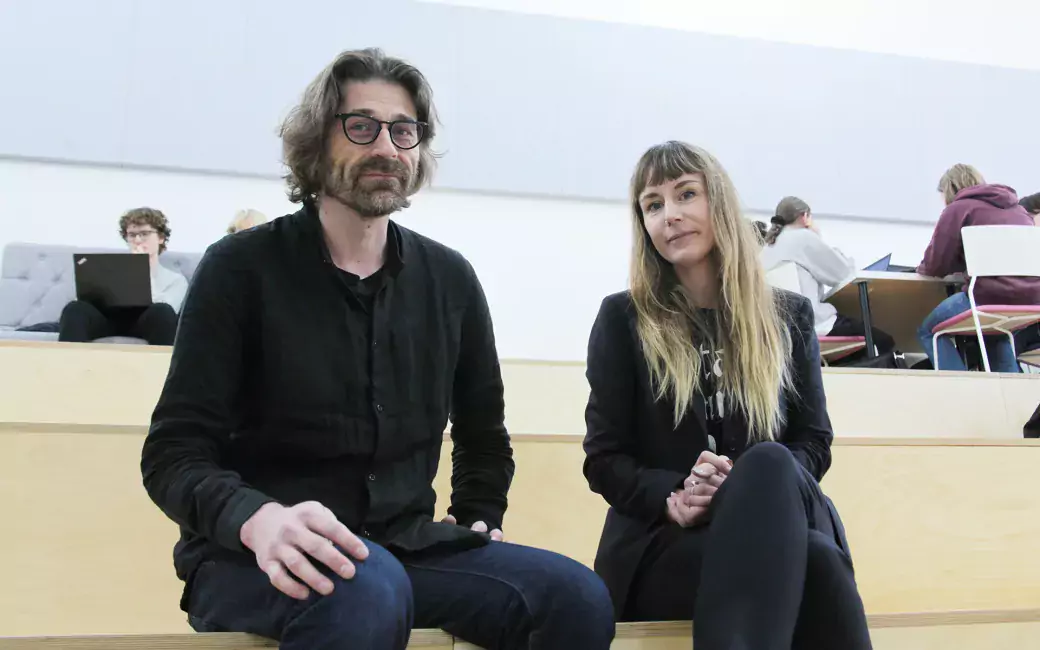Professor Kalle Juuti and teacher Erika Perttuli-Borobio are utilising digital tools and investigating the entire arc of learning with the help of video reports produced by pupils.

Professor Kalle Juuti from the University of Helsinki's Faculty of Educational Sciences studies learning in digital school environments. His field of research is extensive.
"Today, there are plenty of digital tools available for teaching, as well as working methods based on them. However, their use in teaching and their significance to learning remains scarcely studied," Juuti notes.
Professor Juuti's research relies heavily on cooperation between the school and researchers. In Kulosaari Secondary School in Helsinki, collaboration between researchers and teachers encompasses the STEAM fields (science, technology, engineering, arts and mathematics) in their entirety.
In Kulosaari, an illustrated canvas bag, which seventh-grade students design and produce, serves as a research tool. The assignment allows pupils to make use of professional tools, from drawing and image editing software to printing and vinyl cutting.
During this long-term project lasting 20 hours, each pupil chooses from the 17 Sustainable Development Goals outlined in Agenda 2030 the one they consider the most meaningful, promoting it through the illustration on the bag. The goals of Agenda 2030 include zero hunger, gender equality, responsible consumption, peace and justice.
At the same time, researchers employ an easy-to-use digital portfolio platform to collect information on the essential features and other aspects of the pupils' learning process. After each project lesson, pupils record short videos on the platform, describing what took place in the lesson and why. In other words, each pupil's feedback eventually encompasses the entire arc of learning.
Real life instead of a laboratory setting
Teaching experiments are planned collaboratively by teachers and researchers, and the class operates as normally as possible under the direction of its teacher.
"Research becomes part of regular learning, as teachers who work with pupils are involved in and responsible for getting things done. They connect the substance of the teaching experiment to what the pupils have done previously and what they will do next," Juuti notes.
The participating researchers and teachers continually discuss the goal of collaboration from the pupils' perspective. Both parties have professional responsibility for pupil development. At the same time, experts in both fields get to realise their goals.
Collaboration requires an open mind from both researchers and teachers, as many of the emerging issues are entirely new. Thanks to their profession, researchers are in fact more familiar with entering uncharted waters.
"At its best, research brings you face to face with something unknown to science. It's about things that no one else in the world really knows," Juuti says.
A teacher becomes a researcher
Erika Perttuli-Borobio, visual arts and STEAM teacher at Kulosaari Secondary School, initially joined the project as a teacher. These days, she also works as a researcher, writing her doctoral thesis at the University of Helsinki.
At the core of Perttuli-Borobio's doctoral thesis are computational thinking (CT) skills and making them visible to the learner. Solutions produced using CT skills can be utilised in various contexts of knowing, exploring and doing.
CT skills include decomposition (splitting the matter at hand into its constituent parts), abstraction, use of algorithms, elimination of errors, repetition and generalisation.
"Pupils are guided to identify, during their work, what kind of thinking they are using at any given time. The goal is that they learn to utilise in creative activities these ways of thinking characteristic of computer science. I would particularly like to see CT skills as a tool of thinking for learners themselves," Perttuli-Borobio says.
The collaboration is linked to the MaSCoT project of Finnish, Norwegian and Danish researchers, which focuses on utilising novel technical solutions in problem-solving related to teaching. The project aims to develop ways of thinking for learning typical of computer science related to mathematics and the natural sciences in particular.






